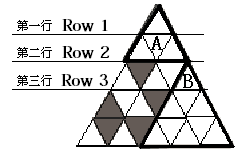NOI '98 P4 - Scarf Cutting
View as PDFNational Olympiad in Informatics, China, 1998
The tailor has a very precious scarf. Unfortunately, parts of the scarf have been ruined by moth bites. Obviously, he doesn't want to just throw it away, so he decides to cut the scarf into two little scarves to give to his two daughters. Of course, the larger the total area between the two scarves, the better.
His scarf is currently an equilateral triangle that has been evenly
split into (horizontal) sections. Furthermore, it has been evenly
divided into
cells. Each cell is an equilateral triangle
with an area of 1. The figure below depicts a scarf for
. The
shaded area represents the cells which have been bitten by moths. From
top to bottom, the triangle is divided into
rows, where the first
row has 1 cell, and the second row has 3 cells in which two have the
shape △ and 1 has the shape ▽ (these two types of triangles we shall
consider congruent). The third line has 5 cells, in which 3 have the
shape △ and 2 have the shape ▽, and so on. Using coordinates
to denote the position of cells, the first row's cell has the
coordinate
; the cells in the second row have coordinates
,
,
respectively; …

The rules for cutting the scarf is as follows:
- The shape of the two smaller triangles must be exactly the same as the larger one (equilateral).
- Neither of the smaller triangles should contain moth bitten cells.
- Cuts may only be made on the borders of cells.
- The total area of the two small triangles must be maximized.
In the diagram above, the best way to cut is along the bolded lines, for
a total area of . You are to write a program that solves this
problem for the tailor.
Input Specification
The first line of input contains the integer
,
indicating that the scarf consists of
total cells. The
second line contains the integer
, the
number of cells that have been bitten by moths. There will be
lines
to follow with two integers
and
on each line, giving the
coordinates of the moth-bitten cells. Adjacent numbers in the input may
be separated by one or more spaces.
Output Specification
You should output one integer - the maximum possible value for the total area between the two smaller triangles if the tailor cuts optimally.
Sample Input
5
5
3 2
4 1
4 4
5 4
5 2Sample Output
13Problem translated to English by .
Comments